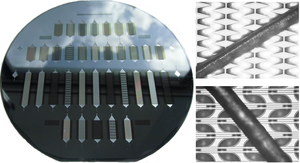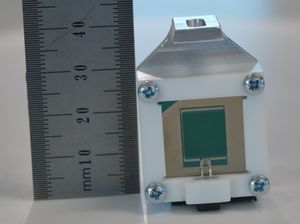Micro-Propulsion
Without a dedicated propulsion system, nano-satellite platforms can never totally realize the potential of replacing their larger counterparts, imposing a limit on the exponential growth that CubeSats launches have shown in recent years. Propulsive capabilities would enable them to engage in a wider range of missions such as those characterized by many satellites flying in formation or in a constellation, possibly even in very low-altitude orbits. The strict mass, volume, and power limitations typically imposed by nano-satellite requirements need unique micro-technologies to help develop a compliant propulsion system. Micro-ElectroMechanical Systems (MEMS) at a micro-scale size and high level integration are very good examples of suitable technologies for this class of satellites.
In the aerospace industry there is currently a growing interest in green, non-toxic propellants. Unfortunately, especially when chemical propulsion concepts are considered, a large portion of the good-performance propellants are apt to be a very active chemical, and most of them are corrosive, flammable, and/or toxic. An alternative is to use electro-thermal propulsion, which allows good performance but also the use of “green” propellants. One of the most typical “green” propellant choices is the use of an inert gas. However, this leads to large storage tanks or, alternatively, to excessively high tank pressures. Ice or liquid water are other potentially promising green propellants, due to their high mass density and low molecular mass.
The Space Engineering Department is well known for its work on the design, development and launch of educational nano-satellites. The study and development of micro-propulsion systems for this class of small satellites is one of the most important short to medium term objectives in our current roadmap. We are presently researching two types of water-propelled micro-resistojets, mostly based on MEMS technologies: a low-pressure free molecular concept, and a more conventional one based on vaporization of liquid water. Both these concepts offer several advantages, including: high integration capability, small volume, light mass, fast response, high thrust-mass ratio, high reliability, and easy applicability to a thruster array. They offer very similar performance but, at the same time, they are complementary to each other in terms of operational conditions (in particular, the allowed propellant storage temperature and pressure). The MEMS components of these thrusters are manufactured through a collaboration with TU Delft’s Else Kooi Laboratory, taking advantage of the wide expertise of this partner in advanced MEMS systems research.
- The liquid water concept thermally gasifies liquid water to a high temperature vapor for expulsion via a conventionally shaped nozzle, and has a wide potential for in-orbit maneuvers of nano-satellites. The general structure of the thruster is based on a modular design, in which the different parts (inlet section, heating chamber, nozzle) can be interchanged in order to test different combinations of concepts. The resistive micro-heater elements are made of either Silicon Carbide or Molybdenum, based on technologies recently developed at the Else Kooi Laboratory.
- The free molecular concept, with its low plenum gas pressure of less than 1000 Pa, can provide a thrust level on the order of several mN to a few mN and is suitable for precise attitude control of nano-satellites. In the baseline idea, water is stored in the tank as ice and operates below its triple point, under sublimating conditions: the ice molecules sublimate to maintain the pressure inside the tank equal to the vapour pressure (approximately 600 Pa at 0 °C). The molecules then move from the tank through the feed system into a plenum, and finally flow through one or more micro-channels with high-temperature walls, which in this concept are at the same time the heating elements and the expansion slots.
| Parameter | Liquid Water, Resistojet | Free Molecular Resistojet | [Unit] |
|---|---|---|---|
| Chamber/Channel temperature | 550 | 573 | [K] |
| Chamber/Plenum pressure | 5x105 | 150 | [Pa] |
| Propellant mass flow rate | 1.63 | 1.32 | [mg/s] |
| Power transferred to water | 5.25 | 4.51 | [W] |
| Thrust (vacuum) | 1.52 | 1.14 | [mN] |
| Specific impulse (vacuum) | 94.9 | 88.1 | [s] |
| Total impulse | 46.4 | 43.2 | [Ns] |
| Propellant mass | 50 | 50 | [g] |
| Propellant mass | < 360 | < 330 | [g] |
Table: Target performance of the two micro-propulsion concepts when used in a typical CubeSat mission, under comparable operational conditions with the same amount of propellant.
-
In parallel, the group is also actively researching other advanced and unconventional micro-propulsion concepts. To this end, a research project has recently been started, aiming at studying a prototype of solar thermal system capable of efficiently co-generating electric/thermal power and propulsion in small spacecraft. The integrated system under consideration includes one or more solar concentrators, transferring thermal power to the working fluid of a high‑temperature Organic Rankine Cycle turbogenerator, and to one or more thrusters. Its main innovation is to effectively combine the two functions of power generation and space propulsion into a single integrated system, by using part of the solar thermal energy for propulsion and employing the turbogenerator discharge heat for energy storage or thermal control.

Left: a MEMS wafer with several liquid water micro-resistojet design concepts. Right: SEM-microscope detail of two different types of heating sections (for comparison, the thick black strips in the pictures are a human hair).

A prototype of the free molecular micro-thruster (not including the main tank). The green rectangular area in the center is the heating/expansion slot, which in this case includes an array of circularly-shaped channels.

Microscope detail of some of the circular heating/expansion channels of the prototype shown in the previous picture.
-
- A. Cervone, B. Zandbergen, D.C. Guerrieri, M. de Athayde Costa e Silva, I. Krusharev, H. van Zeijl, 2016, “Green Micro-Resistojet Research at Delft University of Technology: New Options for Cubesat Propulsion”, CEAS Space Journal D.C.
D.C. Guerrieri, A. Cervone, E. Gill, 2016, “Analysis of Non-Isothermal Rarefied Gas Flow in Diverging Microchannels for Low Pressure Micro-Resistojets”, ASME Journal of Heat Transfer
A. Cervone, A. Mancas, B. Zandbergen, 2015, “Conceptual Design of a Low-Pressure Micro-Resistojet Based on a Sublimating Solid Propellant”, Acta Astronautica
T. van Wees, C. Hanselaar, E. Jansen, I. Granero, A. Cervone, B. Zandbergen, H. van Zeijl, 2016, “Design, Fabrication, Testing and Modeling of a Vaporizing Liquid Micro-Propulsion System”, ESA Space Propulsion Conference
M. de Athayde Costa e Silva, D.C. Guerrieri, A. Cervone, 2016, “State Space Modelling of Fluid Flow for Thrust Control in MEMS-Based Micro-Propulsion”, ESA Space Propulsion Conference
D.C. Guerrieri, M. de Athayde Costa e Silva, B. Zandbergen, A. Cervone, 2016, “Heater Chip with Different Microchannels Geometries for a Low Pressure Free Molecular Micro-Resistojet”,ESA Space Propulsion Conference
M. de Athayde Costa e Silva, D.C. Guerrieri, A. Cervone, 2015, “Investigation of Innovative Thrust-Vector Control Techniques for Micro Propulsion Systems”, IAF 66th International Astronautical Congress
D.C. Guerrieri, M. de Athayde Costa e Silva, B. Zandbergen, A. Cervone, 2015, “Development of a Low Pressure Free Molecular Micro-Resistojet for Cubesat Applications”, IAF 66thInternational Astronautical Congress
J.J. Preijde, A. Cervone, 2015, “Design and Modelling of a New Concept of Solar Thermal Propulsion & Power System for Small Satellites: Feasibility and Perspectives”, IAF 66thInternational Astronautical Congress
C. Wang, B. Zandbergen, A. Cervone, J. Chu, 2015, “Numerical Studies on Performance of Free Molecule Micro-Resistojet with Ice Propellant”, 6th European Conference for Aeronautics and Space Sciences (EUCASS)
A. Cervone, A. Deeb, T. van Wees, E. Jansen, P. Sundaramoorthy, J. Chu, B. Zandbergen, 2015, “A Micro-Propulsion Subsystem to Enable Formation Flying on the DelFFi Mission”, 8thInternational Workshop on Satellite Constellations and Formation Flying
R. Poyck, A. Cervone, B. Zandbergen, H.W. van Zeijl, I. Krusharev, Q. Bellini, 2014, “A Water-Fed Micro-Resistojet for the DelFFi Formation Flying Mission”, IAF 65th International Astronautical Congress
I. Krusharev, R. Poyck, Q. Bellini, B. Zandbergen, A. Cervone, 2014, “Cubesat Micro-Propulsion Systems for Extending the Capabilities of Academic Projects”, IAF 65thInternational Astronautical Congress
R. Bijster, B. Zandbergen, 2014, “Integration of a Variable Turn-Density Coil Actuator in a Micropropulsion Thrust Stand”, ESA Space Propulsion Conference
B. Zandbergen, 2013, “Micropropulsion systems for Cubesats”, Von Karman Institute for fluid dynamics
A. Cervone, B. Zandbergen, J. Guo, E. Gill, W. Wieling, F. Tata Nardini, C. Schuurbiers, 2012,“Application of an Advanced Micro-Propulsion System to the DelFFi Formation-Flying Demonstration Within the QB50 Mission”, IAF 63rd International Astronautical Congress
Contacts

Dr. A. (Angelo) Cervone
Assistant Professor
✉ A.Cervone@tudelft.nl